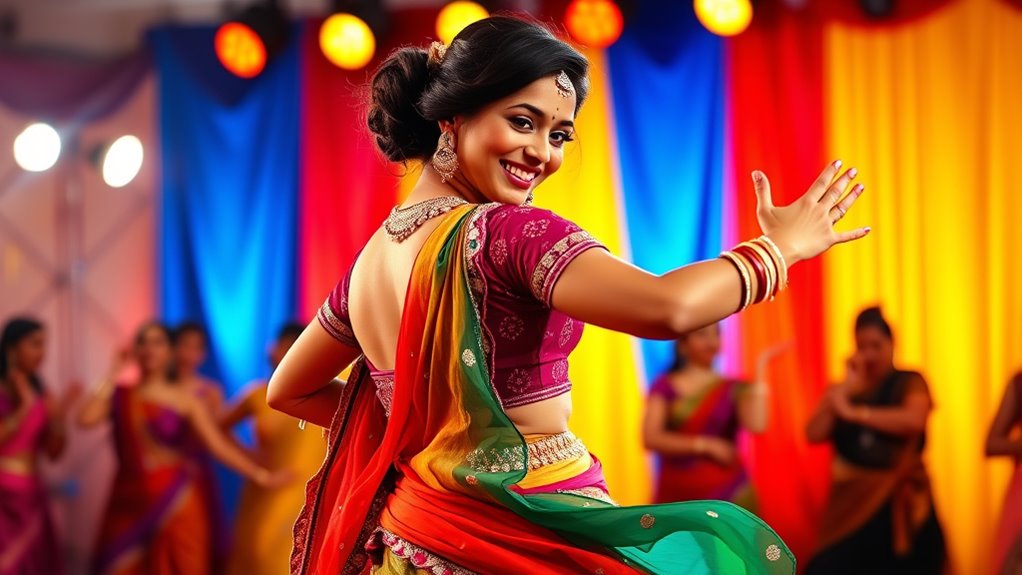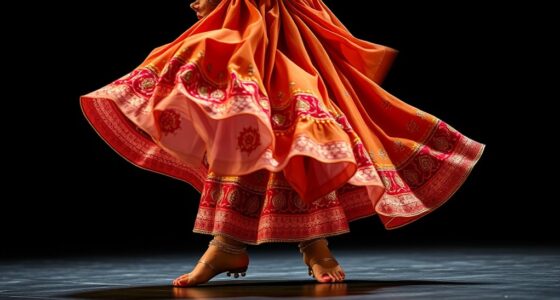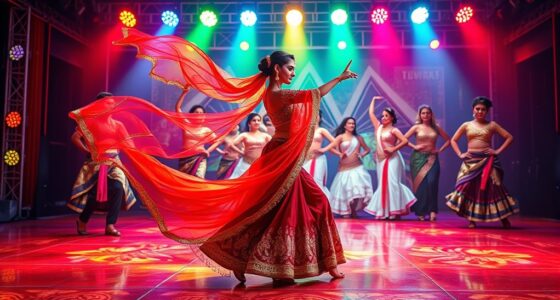The “thumka” is a vibrant Bollywood dance move that highlights quick, rhythmic hip thrusts synchronized with music beats. Originating from traditional Indian dance forms like Kathak and folk dances, it’s now a signature gesture symbolizing celebration, joy, and energy. Performed with a playful attitude, the move combines simplicity with expressive power and fits seamlessly into various dance styles. If you want to uncover more about its cultural roots and how it’s evolved, keep exploring.
Key Takeaways
- The thumka is characterized by quick, rhythmic hip thrusts synchronized with music beats, originating from traditional Indian dance forms.
- It involves playful, expressive movements that convey emotions like joy, flirtation, or mischief in Bollywood performances.
- The move combines simplicity with energetic flair, adaptable across folk, classical, and contemporary dance styles.
- Digital tools and AI now assist in creating, analyzing, and evolving thumka choreography, keeping it relevant in modern dance.
- As a signature element, the thumka amplifies mood shifts and adds vibrancy to high-energy dance routines and party scenes.

Have you ever wondered what a “thumka” really is? If you’ve watched Bollywood films or dance performances, you’ve likely seen this lively hip movement that instantly grabs attention. The thumka is more than just a dance step; it’s a vibrant expression rooted in decades of dance origins and cultural significance. Its origins trace back to traditional Indian dance forms like Kathak and folk dances, where rhythmic hip movements played a vital role in storytelling and conveying emotion. Over time, these movements evolved and merged with modern dance styles, giving birth to the energetic thumka we see today in Bollywood. It’s become a signature move that captures the essence of Indian dance’s rich history, blending classical roots with contemporary flair.
The cultural significance of the thumka goes beyond just a dance move. It’s a symbol of celebration, joy, and vibrancy, often used to amplify the mood of a song or scene. When a dancer performs a thumka, it’s not just about the physical movement but about conveying an emotion—be it flirtation, excitement, or mischief. Bollywood choreographers have popularized this move, making it a staple in many dance routines, especially during high-energy songs. The thumka also acts as a visual cue for the audience, signaling a shift in tone or mood, and it helps connect viewers to the cultural fabric of the story. Its widespread use makes it a cultural marker, representing the lively spirit of Indian entertainment.
What makes the thumka particularly engaging is its simplicity combined with its expressive power. The move involves a quick, rhythmic thrust of the hips, often synchronized with music beats, and performed with a playful attitude. Its versatility allows dancers to adapt it to various styles, from traditional folk dances to modern hip-hop, cementing its place as a dance staple. When you perform or watch a thumka, you’re witnessing a dance form that embodies centuries of cultural evolution—an energetic gesture that encapsulates the vibrancy and spontaneity of Indian dance traditions. Whether used to highlight a romantic moment or to elevate a party scene, the thumka continues to be a symbol of Indian dance’s lively, expressive nature, connecting generations through movement.
Additionally, recent developments in AI technology have influenced dance choreography, making it easier to create and analyze dance moves like the thumka through digital tools.
Frequently Asked Questions
How Did the Thumka Originate in Bollywood Dance?
You might wonder how the thumka originated in Bollywood dance. It evolved as a natural expression of vibrant hip movements that add flair and energy to performances. Influenced by traditional Indian dance forms and the lively spirit of Bollywood, dancers began emphasizing hip sways to convey emotion and rhythm. Over time, the thumka became a signature move, symbolizing the lively, expressive essence of Bollywood dance and its dynamic choreography.
Are There Specific Songs Where Thumka Is Most Prominent?
You’ll notice the thumka shines brightest in classic Bollywood hits like “Kajra Re” and “Choli Ke Peeche,” where dance floor trends highlight its energetic flair. Costume considerations also come into play, with flowing skirts or fitted outfits emphasizing the hip movements. These songs showcase the thumka’s vibrant appeal, making it a staple move that captures the rhythm and spirit of Bollywood dance.
Can Thumka Be Incorporated Into Non-Bollywood Dance Styles?
You can definitely incorporate thumka into non-Bollywood dance styles by using fusion techniques and cultural adaptations. By blending the signature hip movement with styles like jazz, hip-hop, or contemporary, you create a unique dance expression. Focus on maintaining the energy and rhythm of the thumka while adapting it to fit the new style, allowing your performance to showcase both traditional flair and innovative creativity.
What Are the Common Mistakes to Avoid While Performing Thumka?
Think of performing thumka like riding a bicycle—you need balance and coordination. Common mistakes include poor posture correction, which throws off the flow, and incorrect hand placement that distracts from the move’s rhythm. To avoid these, keep your back straight, engage your core, and position your hands properly. Practicing in front of a mirror helps spot these errors early, ensuring your thumka stays smooth and confident.
Is Thumka Suitable for All Age Groups?
You might wonder if thumka is suitable for all age groups. It’s generally culturally appropriate and can be adapted to fit different age levels. Younger dancers might perform it with more energy, while older individuals can do a softer version. Just consider age suitability and comfort, ensuring the move respects cultural norms and personal limits. With proper modifications, everyone can enjoy the fun and expressive nature of thumka.
Conclusion
Now that you know what a thumka really is, you can’t unsee it the next time you watch a Bollywood dance number. It’s more than just a hip sway; it’s a cultural icon, blending tradition with a dash of modern flair. Think of it as the dance floor’s version of a Mona Lisa smile—timeless and instantly recognizable. So next time you’re at a party, channel your inner Bollywood star and let that thumka steal the show!








